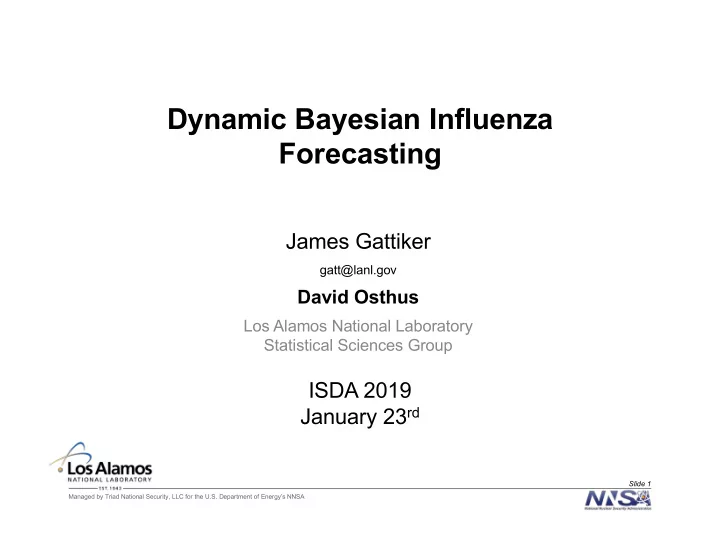

Dynamic Bayesian Influenza Forecasting James Gattiker gatt@lanl.gov David Osthus Los Alamos National Laboratory Statistical Sciences Group ISDA 2019 January 23 rd Slide 1 Managed by Triad National Security, LLC for the U.S. Department of Energy’s NNSA
Acknowledgments Talk based on: Osthus, Dave, James Gattiker, Reid Priedhorsky, and Sara Y. Del Valle. "Dynamic Bayesian influenza forecasting in the United States with hierarchical discrepancy." Bayesian Analysis (2018). Slide 2 Managed by Triad National Security, LLC for the U.S. Department of Energy’s NNSA
Acknowledgments Talk based on: Osthus, Dave, James Gattiker, Reid Priedhorsky, and Sara Y. Del Valle. "Dynamic Bayesian influenza forecasting in the United States with hierarchical discrepancy." Bayesian Analysis (2018). Dave Osthus is the Investigator for this work in methodology and applied modeling Thanks, Dave: Slide 3 Managed by Triad National Security, LLC for the U.S. Department of Energy’s NNSA
Statistics and Uncertainty Quantification Statistics: • Model trends & patterns in data for prediction and discovery • Statistical model inherently represents uncertainty Uncertainty Quantification (one thread: statistical) • Use data and domain models for prediction and discovery – often, domain models are computational simulations – domain models are a different type of information from observations or priors • As a statistical model, includes uncertainty in inferences – including: parameters, model inadequacy, data uncertainty Uncertainty Quantification (another thread: numerical analysis) • Concept based in solution methods for ODE systems • Extend to unknown parameters and linking to data • Make inferences, including uncertainty Slide 4 Managed by Triad National Security, LLC for the U.S. Department of Energy’s NNSA
Uncertainty Quantification Key Advances in Statistical UQ in early 2000’s * • Based on work in response surface methods for approximating the output of computationally expensive models • Markov-Chain Monte Carlo for inverse computations for Bayesian modeling Discrepancy Observed data System model • Using the statistical concept of a “discrepancy” between model and data. * Kennedy and O’Hagan, Bayesian Calibration of Computer Models, JRSS-B, 2001 Slide 5 Managed by Triad National Security, LLC for the U.S. Department of Energy’s NNSA
Uncertainty Quantification: Discrepancy Discrepancy Observed data System model Discrepancy considerations • Capture the potential shortfalls of the model • Consistent with the domain being modeled • Discrepancy and parameter bias trade off • Justify in extrapolation Slide 6 Managed by Triad National Security, LLC for the U.S. Department of Energy’s NNSA
Overview • Flu surveillance, data and forecasting objectives • Model inadequacy and discrepancy • Dynamic Bayesian (DB) model with hierarchical discrepancy • Forecasting results and conclusions Slide 7 Managed by Triad National Security, LLC for the U.S. Department of Energy’s NNSA
Flu surveillance • Centers for Disease Control and Prevention (CDC) Outpatient Influenza-like Illness Surveillance Network (ILINet) monitors influenza-like illness (ILI) levels in the U.S. • Thousands of providers participate in ILINet across the U.S. • ILI is 1. Temperature ≥ 100 ºF 2. A sore throat or cough 3. No other known cause ILI ≠ Influenza Slide 8 Managed by Triad National Security, LLC for the U.S. Department of Energy’s NNSA
Recommend
More recommend